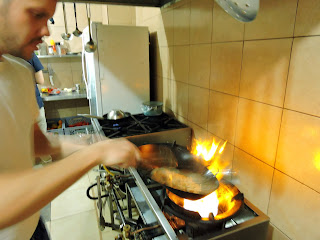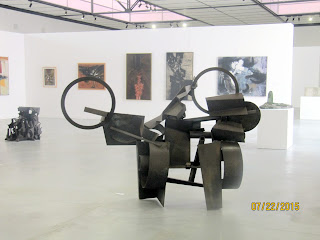One of the delights in living in Cuenca is observing how a richer array of ethnic and fine-dining restaurants with international flavor continue to pop-up throughout the city. One such restaurant is Aji Rocoto, which opened this year; and presents a fine variety of menu specialties that reflect the Peruvian fusion flare of fine dining which has become an international rage, and also has made Lima a hotbed for some of the finest restaurants and cuisines in South America.
How fortunate we are to have the young and affable chef, Michael Wagner, a Peruvian of German ancestry living in Cuenca, and bringing his culinary talents to enhance our taste buds with flavors that are in many ways unique to Cuenca. Chef Wagner is a graduate of the Cordon Bleu Academy in Lima, and brings with him the flavors of the Peruvian dishes; some of which are fused with Chinese, Thai, or Japanese dishes, not to mention Italian as well. Michael and his wife, Daniela Davalos Carrasco, who is a Cuencana, have come with their two young children to make their home in Cuenca; for which we are fortunate to take advantage of the skills and creativity of an important rising star's contribution to the culinary scene in Cuenca.
Let's begin by taking a look at Michael at work in his immaculately clean kitchen of Aji Rocoto as he prepares two entrees for his customers:
Mixing the right amount of oil with the seasonings and vegetables required with a pinch of this and a pinch of that, like any creative chef there is no need for actual measurements.
Achieving a hot flame to quickly sear in the flavors and juices of the meats and vegetables, and knowing just the right amount of time to accomplish the task is a skill in which Michael excels.
In no time at all, a dish is prepared worthy of royalty.
Michael said that he was six years old when he first took an interest in cooking. When others might be making cold sandwiches, Michael began his first endeavor with a hot sandwich right on the stove-top. The fire raged out of control, and Michael sent the pan flying to the floor. It looks like at this juncture, Michael has more than mastered control of an exceedingly hot flame, and in no way allowed his first not so successful cooking encounter to blunt his budding passion. Who would have known at the age of six, where Michael's early spark of interest would someday lead him.
Once Michael has fried the rice, everything is prepared for presentation to his customers. The final garnishments are added. The metal molder will come off just before the dishes are taken from the kitchen, and the customer is enthralled with a feast artistic to the eyes, and with aromas that invite enticement to savor the superb flavors and sauces.
Chef Michael also has two years of training as a pastry chef. He serves a wickedly delicious triple chocolate cheese cake, and he intends to create other pastry delights as well. Appetizers, entrees, and desserts all made from the freshest of ingredients; with entree choices for vegetarians as well.
Sorry folks, the temptation was too great. I made my way more than half way through the triple chocolate cheese cake before I thought to take a photo.
In the above photo, Michael makes his own home-made ravioli.
A full liquor bar is on tab. House wine is a generous glass for six dollars; and the Pisco Sour, the Peruvian national drink made from fermented grapes is worth the indulgence.
Interior of Aji Rocoto
Mixing the right amount of oil with the seasonings and vegetables required with a pinch of this and a pinch of that, like any creative chef there is no need for actual measurements.
Achieving a hot flame to quickly sear in the flavors and juices of the meats and vegetables, and knowing just the right amount of time to accomplish the task is a skill in which Michael excels.
In no time at all, a dish is prepared worthy of royalty.
Michael said that he was six years old when he first took an interest in cooking. When others might be making cold sandwiches, Michael began his first endeavor with a hot sandwich right on the stove-top. The fire raged out of control, and Michael sent the pan flying to the floor. It looks like at this juncture, Michael has more than mastered control of an exceedingly hot flame, and in no way allowed his first not so successful cooking encounter to blunt his budding passion. Who would have known at the age of six, where Michael's early spark of interest would someday lead him.
Once Michael has fried the rice, everything is prepared for presentation to his customers. The final garnishments are added. The metal molder will come off just before the dishes are taken from the kitchen, and the customer is enthralled with a feast artistic to the eyes, and with aromas that invite enticement to savor the superb flavors and sauces.
Chef Michael also has two years of training as a pastry chef. He serves a wickedly delicious triple chocolate cheese cake, and he intends to create other pastry delights as well. Appetizers, entrees, and desserts all made from the freshest of ingredients; with entree choices for vegetarians as well.
Sorry folks, the temptation was too great. I made my way more than half way through the triple chocolate cheese cake before I thought to take a photo.
In the above photo, Michael makes his own home-made ravioli.
A full liquor bar is on tab. House wine is a generous glass for six dollars; and the Pisco Sour, the Peruvian national drink made from fermented grapes is worth the indulgence.
Interior of Aji Rocoto
Dining is cozy and warm. Great for couples, families, friends; and a fine luncheon trade is done with businessmen and professionals. Chef Michael devotes time with his customers, converses with them in English or Spanish, makes menu suggestions, and provides guidance as his customer's needs require.
The Cuisine
Ravioli Fusion: Tender cuts of pork served oriental style on a bed of home-made ravioli. Cooked to perfection, with a totally different way of enjoying ravioli. It was sooo good!
If you're tired of eating rice with every meal in Cuenca. Michael's risotto with tender beef (photo below) will raise rice to a whole new level of taste, and don't forget to try cerviche Nikei, new to Aji Rocoto's menu. Peruvian cerviche is a very different dish from the preparation of Ecuadorian cerviche. In Michael's hands, cerviche takes an additional twist of creativity as it combines Peruvian and Japanese tastes.
https://www.facebook.com/www.ajirocoto.com.ec/
is Aji Rocoto's Facebook page with many beautiful photos of menu items and choices. Don't hesitate to check out the many beef, pork, chicken, seafood, and vegetarian dishes. Dishes can be made to order.
Aji Rocoto is located at
Borreo 5-91 Juan Jaramillo | Corner of Borrero, 5-91, And Juan Jaramillo, Cuenca, Ecuador ( the west side of Borrero a couple of doors down from the corner of Borrero and Juan Jaramillo)
Hours are from:
Tuesday thru Saturday: 12:00 p.m. until 4:00 p.m.
7:00 p.m. until 10:00 p.m.
Sundays open from Noon until 4:00 p.m.
Closed Mondays
Reservations can be made at 099 946 6241.
Buen Provecho!!




































































